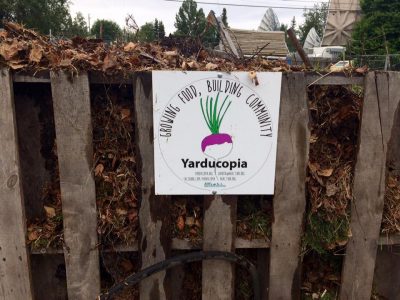Most Alaskan gardeners are creative out of necessity. With a growing season made up of unique light patterns, temperature fluctuations and abbreviated season lengths, gardeners learn to adapt. Gardeners who want to continue growing into the winter months have additional challenges. There is a great deal of information available about season extenders – nothing compares to fresh greens even in the dead of winter. Those who want to harvest their own fresh produce year-round often turn to greenhouses as a solution. However, heating in greenhouses can be a significant expense and can require additional electrical infrastructure if one’s greenhouse is not adjacent to the home or garage. While solar powered heating may be an alternative, it too can be cost prohibitive. One potential solution for the more adventurous at heart is a compost heated greenhouse.
Composting Refresher:
The three most common ways to compost are cold composting, worm composting (vermiculture) and hot composting. Cold composting is simply piling waste material into a designated area and allowing time and nature to do their work. Cold composting is the easiest way to compost as a gardener can add material as it becomes available. But, like all things, this ease comes at a price. Cold composting can take a significant amount of time to create usable compost. Adding material over time can also lengthen the process even more. Worm composting is a rather fun way to compost (particularly with children around). Red worms are used to gobble up food and specific paper waste and create nutrient dense fertilizer. While both worm and cold composting are excellent ways to reduce waste and create soil additions, hot composting is the only form of composting that will provide heat in a winter greenhouse. (For more information on vermiculture please follow this link.)
Hot composting is the process of mixing waste materials to create a ratio of two parts carbon to one part nitrogen. While a quick internet search can provide numerous “compost calculators” a simple way to remember this is to think of carbon material as brown material- paper bags, unpainted cardboard, toilet paper or paper towel rolls, old newspaper or mail, dried leaves, woods chips, hay etc. Nitrogen rich material is considered green material- food waste, grass cuttings, fresh leaves etc. This ratio of two parts brown to one part green is piled into a bin or large heap at one time. This compost pile is then wet down. Within 24-48 hours the temperature in the center of the pile will heat to 141 to 155 degrees Fahrenheit. The pile is turned and watered at regular intervals and will maintain its heat until the compost is ready to be used and then temperature begins to drop. Hot composting is an excellent way to treat plant waste that has come into contact with weed seeds or potential pathogens as the heat can eliminate many of these problems.(If you are interested in composting in general, Matsu Landfill offers a variety of free classes. Click here.)
For those of you who keep livestock companions in/around your garden, hot composting is also an excellent way to utilize chicken, goat, horse, duck manure as green material. Utilizing pig, dog, cat or human manure is a much more complicated activity as these animals can carry potentially harmful pathogens to humans. While many people will compost this manure, it is highly recommended not to compost the material near edible plants or use the compost around gardens intended to produce food for human consumption.
Taking Compost into the Greenhouse:
Composting is something most gardeners are familiar with if only to produce quality compost for the garden itself. Using the heat as a secondary output to grow plants in the winter is not widely practiced but a feasible way to grow into deep winter. The New Alchemy Institute (NAI) in Massachusetts has experimented with sophisticated compost heated greenhouses and used water pipes to move heat around large greenhouses. Composting on a massive scale, they have also documented their findings on the carbon monoxide and ammonia that can be a bi-product of large scale composting. (Find more information at https://attra.ncat.org/attra-pub/viewhtml.php?id=57.) While they have successfully used manure-based compost to heat large greenhouses, this too may not be feasible to a weekend Alaskan gardener. Luckily, there are some more humble variations of this practice that are more low-tech.
Other variations can include small compost bins located around the greenhouse to heat specific areas or a more targeted approach of using a pallet or wood plank across the top of the compost heap to target specific plants that need a warmer and more caring environment. In this way, a gardener can heat specific locations in the greenhouse and apply heat in a targeted way. Using height of the compost bin or plants over the top of the bin can also create microclimates and allow a gardener to have various temperature zones. Another option is to dig compost trenches in the floor of the greenhouse creating rows of compost. An advantage to this method is that, as compost becomes ready the temperature drops. The trench method allows a gardener to stagger compost row timing and keep the heat up throughout the winter. Again, using animal manure that is safe for compost is an ideal way to get rid of abundant animal waste and have plenty of nitrogen heavy “green’’ material in the winter. (For more information on another sophisticated variant of this check out this website.)
While not a widespread practice (yet), a compost heated greenhouse offers the more experimental gardener an opportunity to extend the growing season and create more compost for plants while maintaining a waste treatment system and reducing energy consumption. To gardeners interested in these goals, this might be worth spending a winter or two trying it out!
About Mountain Gardener
Twitter •
